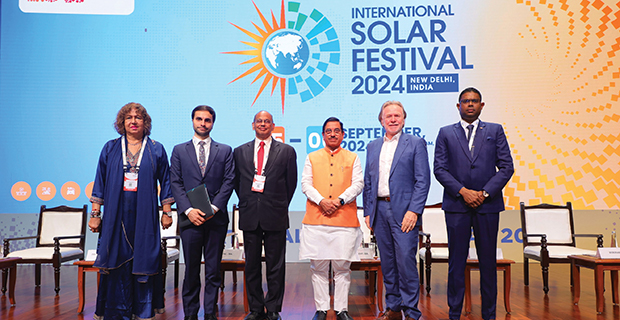A GRAND SUCCESS
(L-R) H.E. Ms Capaya Rodriguez Gonzalez, Ambassador of the Bolivarian Republic of Venezuela to India; H.E. Damien Syed, Deputy Head of Mission, French Embassy in New Delhi Co-President of the ISA Assembly; Dr. Ajay Mathur, Director General, ISA Assembly; Mr. Pralhad Joshi, President of the ISA Assembly and Union Minister of New and Renewable Energy, Government of India; H.E. Philip Green, High Commissioner, Australian High Commission; H.E. Arunkoemar Hardien, Ambassador, Embassy of the Republic of Suriname at the opening session of the First International Solar Festival
We really have the most beautiful planet in our solar system. None other can sustain life like we know it.
—Sunita Williams, Indian-American Astronaut
It was on the sidelines of the 21st Conference of the Parties (CoP 21) on November 30, 2015 in Paris, France, that a momentous event took place. The International Solar Alliance (ISA) was launched jointly by Indian Prime Minister Narendra Modi and the then French President François Hollande. A year later on the sidelines of CoP 22 in Marrakech, Morocco, the ISA Framework Agreement was opened for signatures.
Much like a blue sky in bright sunshine, the ISA’s vision since the very inception has been very clear—One World, One Solar, One Grid. Towards this end, the ISA organized the first-ever International Solar Festival 2024 at the packed Bharat Mandapam in New Delhi between September 5 and 6. Among those who spelt out their achievements and gains were Heads of State, diplomats, business and community leaders, youth, and experts. Today, all UN member nations are eligible to join this formidable alliance that has 119 countries as member and signatory countries.
Nothing moves forward with speed without clarity of mission either. In the case of the ISA it has been to provide a dedicated platform for cooperation among solar resource rich countries—that lie completely or partially between the Tropic of Capricorn and the Tropic of Cancer—and global stakeholders, including bilateral and multilateral organizations, corporate entities and industry. Besides, the goal is to unlock over $ 1,000 billion in solar investments by 2030 in order to reduce technology and financing costs for infrastructure. Meanwhile, India and France continue to hold the presidency and co-presidency of the ISA respectively.
Inaugural addresses are vital in setting the tone and agenda for any global event. Delivering the one for the Festival on September 5, the Indian Prime Minister said, “India’s solar energy capacity has increased 32-fold in the last 10 years. This speed and scale will also help us achieve 500 GW non-fossil capacity by 2030.” He pointed out that “The world must collectively address the imbalance in investments in renewable energy. Solar manufacturing and technology must be democratized to help developing countries. As ISA co-founder, India is committed to working with the world for a green, inclusive future. ISA, through global policy and action, is leading the world to a future powered by the sun.”
He appreciated the ISA’s endeavors in electrifying the global south, particularly Africa, where over 700 million people live without access to uninterrupted power. “In a short time, the ISA has made a lot of progress. In 44 countries, it has assisted in developing nearly 10 GW of electricity. The Alliance has also played a role in bringing down the global prices of solar pumps. Private sector investment is being enabled, especially in African member countries. A number of promising solar startups from Africa, Asia-Pacific, and India are being encouraged. This initiative will also be expanded to Latin America and the Caribbean soon. These are noteworthy steps in the right direction,” he said while emphasizing India’s commitment in every effort to build an “inclusive, clean and green planet”.
In his address at the inaugural program, Mr. Pralhad Joshi, President of the ISA Assembly and Union Minister for New and Renewable Energy, Government of India, averred that “India is committed to supporting the world, particularly the Global South, in advancing an inclusive and sustainable future, drawing on its success in clean energy initiatives. The festival reflects India’s commitment to a sustainable future, inspiring collective action toward an energy transition, led by the government, youth, communities, and the private sector.” He added that India’s installed renewable capacity has increased by 165 percent in the past decade, rising from 76.4 GW in 2014 to 2004 GW in 2024. As a global climate leader, India champions practical, affordable and sustainable solutions that will help the nation to meet their developmental needs.”
Minister Joshi said India’s oldest scriptures such as the Vedas and the Upanishads frequently mentioned the sun as a vital source of life and energy. There are ancient temples dedicated to the sun such as the Konark Sun temple in Odisha, Modhera Sun temple in Gujarat, the Martand Sun temple at Anantnag in Kashmir, the Suryanar Kovil temple in Tamil Nadu, the Balaji Sun temple in Madhya Pradesh, the Katarmal Sun temple in Uttarakhand, the Sri Surya Pahar temple in Assam and the Dakshina temple in Bihar, among others. Interestingly, Modhera village is cent percent solar electrified. The Jantar Mantar Observatory in New Delhi reflects the ancient Indian understanding of the sun’s movement and its significance.











Comments.